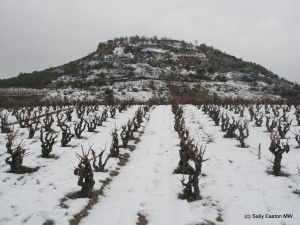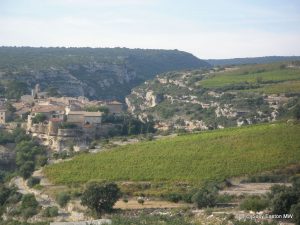Minervois versus Corbières

Corbières, pretty in rare snow (Jan 2010)
I thought it about time I try to get to grips a little with the difference between these two adjacent Languedoc appellations. For too long I’ve not accorded them their individual identities.
Minervois lies to the immediate north and east of Carcassonne, in front of the Montagne de Noire, Corbières to the south and east, stretching to the foothills of the Pyrenees. The river Aude and the Canal du Midi broadly separate the two appellations on its west-east trajectory to the Mediterranean Sea.
Corbières is a big region of 13,500 hectares, with significant topographical diversity. Christine Behey-Molines, export manager for trade and promotion organisation Languedoc Wines explained “there are west to east differences, and lower to higher altitude differences”, and, she added “Corbières is wilder than Minervois. The scenery is rockier and more rustic on the old massif of Corbières.” Soils are also necessarily diverse over such a large area, with sandstones, schists and limestones in different parts, and garrigue an overriding feature. Soils are equally diverse in smaller Minervois, with limestone, red shales, schist and clay marls all featuring.
Both appellations are focused on red wine production, both predicated on the same group of grape varieties, though in slightly differing proportions: predominantly syrah, grenache, lladoner pelut, mourvèdre, carignan and cinsault.
Carignan, especially old carignan, is particularly important in Corbières, much more so than in Minervois, forming part of Corbières’ personality. Here, carignan can comprise up to 50% of the blend. Cinsault must be less than 20%.

Minerve, Minervois
From the 5,000 hectares of Minervois carignan and cinsault are limited to a maximum of 40%. Syrah, mourvèdre, grenache and lledoner pelut must be at least 60%, with the duo of syrah and mourvèdre alone accounting for at least 20% of the blend.
The large size of Corbières means there are many zones, from the Alaric mountains in the north west to the coastal areas of the Mediterranean sea. Generalisations are challenging, at the very least, though Vincent Charleux, winemaker at Abbotts and Delaunay gave it a shot, saying “there are shallow soils in Corbières, and the Alaric mountains of Corbières are a drier climate than the Montagne de Noire” of Minervois.
On wine style, he said “Minervois tends to have more fruit purity, more volume, less tannin, and are easier to drink. The Corbières may become stressed [because they’re drier], giving more tannin and less fruit.” One might imply from this that Minervois can be a little softer and suppler than Corbières.
Frantz Venes, of Château Massamier La Mignarde highlighted this blend differential, adding in that of climate too, saying “Minervois has more syrah and grenache than Corbières, which has more carignan, and a more Mediterranean climate”. Syrah, he added “is more fruity in Minervois, more spicy in Corbières”. He went on to explain “Minervois gets fresh air from the Black Mountain, making it cooler than Corbieres”, added to which there’s more water in Minervois. The west of the appellation gets some mild, moist Atlantic influence too, useful in the summer, while the east adapts to the drier Mediterranean aspect.
Both appellations have a cru segment. Minervois was first off the mark in all of Languedoc with its cru, enshrined in law in 1998. Corbières’ cru Boutenac took until 2005 to hit the statute books.
Of Minervois’ cru La Livinière – 2,600 ha mainly on the slopes of the limestone-based Petit Causses – Venes said “La Livinière is at the north of Minervois, at the edge of the mountain, with very poor soil. It’s impossible to produce big quantities here.” The minimum amount of syrah and mourvèdre is twice that of straight Minervois – at least 40% – and with grenache this trio needs to reach a minimum of 60%. Any remainder may come from lledoner pelut, carignan and cinsault.
Corbières’ cru, Boutenac, only has around 300 of its potential 1,400ha planted. It is rocky terrain around 80 to 100m altitude, with water-retaining deep clay-limestone soils, which is just as well as it’s one of the driest and warmest areas in Corbières. Strong, brooding, sometimes meaty, drought-resistant Carignan remains a key driver of wine style.
Comments
4 Responses to “Minervois versus Corbières”




August 21, 2013 at 12:03 am
Hi Sally,
I just returned from the Hautes-Corbieres and couldn’t agree more on the east-west and high-low differences. What a dramatic landscape. I filmed quite a lot on the region with Jon Bowen of Domaine Sainte Croix and we will be posting pieces onto our Ask a Winemaker page on YouTube as we edit them. When we are ready, I’ll include this article as background in some of our Facebook posts as well. Cheers, Damien
August 21, 2013 at 9:07 am
No problem. I’m pleased you found it useful. Thanks for letting me know. Sally
November 13, 2014 at 5:33 pm
“forming part of Corbières’ personality. Here, carignan must comprise 30-50% of the blend”. Surely Corbières AOC requires a maximum of 50% Carignan.
November 14, 2014 at 10:26 am
Yes, you are right, good spot. Thank you. I think I was using an old rule book. I’ve updated the text.